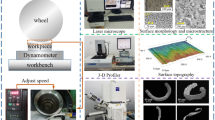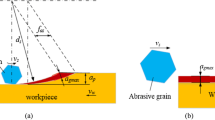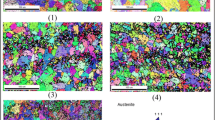Abstract
This paper carries out a finite element (FE) analysis to investigate the effects of grinding speed (20 ∼ 400 m/s) and undeformed chip thickness (1 ∼ 8 μm) on chip formation during single grain grinding of nickel-based superalloy Inconel 718. Three factors related to the Johnson-Cook (J-C) constitutive model, i.e., the strain hardening, strain-rate hardening, and thermal-softening, were taken into account to determine the critical grinding speed. The results show that the chip segmentation frequency increases linearly with increasing the grinding speeds. It was found that the critical grinding speed is 150 m/s based on the variations of equivalent plastic strain, von Mises stress, and grinding force. It was also revealed that the effects of strain hardening and strain-rate hardening on the chip formation are more significant than that of the thermal softening when a grinding speed is below 150 m/s. However, if the grinding speed exceeds this critical value, thermal softening becomes a dominant factor.
Similar content being viewed by others
References
Shi Z, Malkin S (2006) Wear of electroplated CBN grinding wheels. J Manuf Sci Eng Trans ASME 128:110–118
Wang JS, Gong YD, Abba G, Antoine JF, Shi JS (2009) Chip formation analysis in micromilling operation. Int J Adv Manuf Technol 45:430–447
Chen ZZ, Tian L, Fu YC, Xu JH, Ding WF, Su HH (2012) Chip formation of nickel-based superalloy in high speed grinding with single diamond grain. Int J Abras Technol 5(2):93–106
Öpöz TT, Chen X (2015) Experimental study on single grit grinding of Inconel 718. Proc Inst Mech Eng B J Eng Manuf 229(5):713–726
Öpöz TT, Chen X (2012) Experimental investigation of material removal mechanism in single grain grinding. Int J Mach Tools Manuf 63:32–40
Feng BF, Cai GQ, Sun XL (2006) Groove, chip and force formation in single-grain high-speed grinding. Key Eng Mater 304–305:196–200
Yoshida T, Syoji K, Kuriyagawa T (1999) Groove formation characteristics of ceramics in single-grain grinding, Brinsbane, Australia: 3rd International Conference on Abrasive Technology
Tawakoli T, Kitzig H, Lohner RD (2013) Experimental investigation of material removal mechanism in grinding of alumina by single-grain scratch test. Adv Mater Res 797:96–102
Aurich JC, Steffes M (2011) Single-grain scratch tests to determine elastic and plastic material behavior in grinding. Adv Mater Res 325:48–53
Zhang LC, Zarudi I (2001) Towards a deeper understanding of plastic deformation in mono-crystalline silicon. Int J Mech Sci 43:1985–1996
Zarudi I, Zhang LC (2000) On the limit of surface integrity of alumina by ductile-mode grinding. J Eng Mater Technol Trans ASME 122:129–134
Chen JB, Fang QH, Zhang LC (2014) Investigation on distribution and scatter of surface residual stress in ultra-high speed grinding. Int J Adv Manuf Technol 75:615–627
Sima M, Özel T (2010) Modified material constitutive models for serrated chip formation simulations and experimental validation in machining of titanium alloy Ti–6Al–4V. Int J Mach Tools Manuf 50:943–960
Guo YB, Yen DW (2004) A FEM study on mechanisms of discontinuous chip formation in hard machining. J Mater Process Technol 155–156:1350–1356
Calamaz M, Coupard D, Girot F (2008) A new material model for 2D numerical simulation of serrated chip formation when machining titanium alloy Ti-6Al-4V. Int J Mach Tools Manuf 48:275–288
Yu JC, Jiang F, Rong YM, Xie H, Suo T (2014) Numerical study the flow stress in the machining process. Int J Adv Manuf Technol 74:509–517
Mahdi M, Zhang LC (1999) Applied mechanics in grinding, part VII: Residual stresses induced by the full coupling of mechanical deformation, thermal deformation and phase transformation. Int J Mach Tools Manuf 39:1285–1298
Wang B, Liu ZQ (2014) Investigations on the chip formation mechanism and shear localization sensitivity of high-speed machining Ti6Al4V. Int J Adv Manuf Technol 75:1065–1076
Soo SL, Aspinwall DK, Dewes RC (2004) 3D FE modelling of the cutting of Inconel 718. J Mater Process Technol 150:116–123
Yang BS, Xu JH, Fu YC, Wei WH (2012) Finite element modeling of machining of hydrogenated Ti-6Al-4V alloy. Int J Adv Manuf Technol 59:253–261
Duan CZ, Wang ZX, Li HH (2014) Finite element simulation of the formation process of a serrated chip in high-speed cutting. J Harbin Eng Univ 35(2):226–232
Shams A, Mashayekhi M (2012) Improvement of orthogonal cutting simulation with a nonlocal damage model. Int J Mech Sci 61:88–96
Hooputra H, Gese H, Dell H, Werner H (2004) A comprehensive failure model for crashworthiness simulation of aluminium extrusions. Int J Crashworthiness 9(5):449–464
Zhou L, Huang ST, Wang D, Xu XL (2011) Finite element and experimental studies of the cutting process of SiCp/Al composites with PCD tools. Int J Adv Manuf Technol 52:619–626
Ozel T (2009) Computational modelling of 3D turning: influence of edge micro-geometry on forces, stresses, friction and tool wear in PcBN tooling. J Mater Process Technol 209:5167–5177
Li K, Gao XL, Sutherland JW (2002) Finite element simulation of the orthogonal metal cutting process for qualitative understanding of the effects of crater wear on the chip formation process. J Mater Process Technol 127:309–324
Özel T, Zeren E (2007) Finite element modeling the influence of edge roundness on the stress and temperature fields induced by high-speed machining. Int J Adv Manuf Technol 35:255–267
Buhl S, Leinenbach C, Spolenak R, Wegener R (2013) Failure mechanisms and cutting characteristics of brazed single diamond grains. Int J Adv Manuf Technol 66:775–786
Yang QB, Liu ZQ, Wang B (2012) Characterization of chip formation during machining 1045 steel. Int J Adv Manuf Technol 63:881–886
Cotterell M, Byrne G (2008) Dynamics of chip formation during orthogonal cutting of titanium alloy Ti-6Al-4V. CIRP Ann Manuf Technol 57:93–96
Molinari A, Musquar C, Sutter G (2002) Adiabatic shear banding in high speed machining of Ti–6Al–4V: Experiments and modeling. Int J Plast 18:443–459
Hortig C, Svendsen B (2007) Simulation of chip formation during high-speed cutting. J Mater Process Technol 186:66–76
Shet C, Deng XM (2000) Finite element analysis of the orthogonal metal cutting process. J Mater Process Technol 105:95–109
Shi GQ, Deng XM, Shet C (2002) A finite element study of the effect of friction in orthogonal metal cutting. Finite Elem Anal Des 38:863–883
Sun S, Brandt M, Dargusch MS (2009) Characteristics of cutting forces and chip formation in machining of titanium alloys. Int J Mach Tools Manuf 49:561–568
Bäker M (2006) Finite element simulation of high-speed cutting forces. J Mater Process Technol 176:117–126
Author information
Authors and Affiliations
Corresponding authors
Rights and permissions
About this article
Cite this article
Dai, J., Ding, W., Zhang, L. et al. Understanding the effects of grinding speed and undeformed chip thickness on the chip formation in high-speed grinding. Int J Adv Manuf Technol 81, 995–1005 (2015). https://doi.org/10.1007/s00170-015-7265-1
Received:
Accepted:
Published:
Issue Date:
DOI: https://doi.org/10.1007/s00170-015-7265-1




